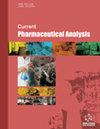通过开发和验证稳定性指示 RPHPLC 方法测定散剂和栓剂中的美沙拉敏
IF 1.5
4区 医学
Q4 PHARMACOLOGY & PHARMACY
引用次数: 0
摘要
背景:本研究开发并验证了一种简便、经济、稳定的 RP-HPLC 方法,用于估算散装和药物剂型中的美沙拉敏含量。方法:采用等度高效液相色谱法,使用反相 HiQSilC18 色谱柱(250 x 4.6 mm, 5μm),流动相为甲醇:乙酸铵缓冲液(90:10 v/v),流速为 1 mL/min,柱温为 25°C。检测波长为 305 nm,进样量为 20μl。所开发的方法按照 ICH Q2 指南进行了验证。美沙拉敏经过了各种应力测试条件的考验,如酸和碱的水解、热降解、氧化和光解。此外,还对方法的线性度、准确度、精密度和稳健性进行了验证。结果美沙拉敏的 RT 为 3.550 分钟 ± 0.024 分钟,为其鉴定提供了可靠的标记。该方法在 5-30 μg/mL 浓度范围内呈线性关系,线性相关系数为 0.994。这表明该方法能够准确测定不同浓度的美沙拉敏。此外,甲沙胺的回收率约为 100%,证实了所开发方法的准确性。系统适用性参数也在可接受的范围内。力降解研究增强了该方法在各种降解情况下检测甲沙胺的选择性和灵敏度。值得注意的是,美沙胺在酸性环境中降解明显。结论总之,我们提出的 RP-HPLC 方法为分析散装和药物剂型中的美沙敏提供了灵敏、准确和精确的方法:经测定,美沙拉敏的RT为3.560 min ± 0.034 min,为其鉴定提供了可靠的标记。该方法在 5-30 μg/mL 浓度范围内呈线性关系,线性相关系数(R²)为 0.987。这表明该方法能够准确测定不同浓度的美沙拉敏。此外,甲沙胺的回收率约为 100%,证实了所开发方法的准确性。系统适用性参数也在可接受范围内。力降解研究增强了该方法在各种降解情况下检测甲沙胺的选择性和灵敏度。值得注意的是,甲沙胺在酸性环境中降解明显。本文章由计算机程序翻译,如有差异,请以英文原文为准。
Determination of Mesalamine in Bulk and Suppository Dosage Forms through the Development and Validation of Stability- indicating RPHPLC Method
Background: In the current study, a simple and cost-effective stability-indicating RP-HPLC method was developed and validated to estimate the mesalamine from both bulk and pharmaceutical dosage forms. Methods: An isocratic HPLC method using a reverse phase HiQSilC18 column (250 x 4.6 mm, 5μm) and a mobile phase methanol: ammonium acetate buffer (90:10 v/v) were employed as the mobile phase with a flow rate of 1 mL/min at 25°C. Detection was carried out at 305 nm, and the injection volume was 20μl. The developed method was validated as per ICH Q2 guidelines. Mesalamine has been subjected to various stress testing conditions, such as hydrolysis of acid and base, thermal degradation, oxidation, and photolysis. Also, methods have been validated with regard to linearity, accuracy, precision, and robustness. Results: The RT of mesalamine was determined to be 3.550 min ± 0.024 minutes, providing a reliable marker for its identification. The method was found to be linear between 5-30 μg/mL concentration with (R²) of 0.994. This demonstrated the method's ability to measure varying concentrations of mesalamine accurately. Additionally, the percentage recovery of mesalamine was approximately 100%, confirming the accuracy of the developed method. The parameters for system suitability have also been found to be within acceptable limits. Force degradation studies reinforced the method's selectivity and sensitivity in detecting mesalamine under various degradation scenarios. Notably, mesalamine significantly degraded in an acidic environment. Conclusion: In conclusion, our proposed RP-HPLC method provides a sensitive, accurate, and precise means of analyzing mesalamine in both bulk and pharmaceutical dosage forms. result: The RT of mesalamine was determined to be 3.560 min ± 0.034 minutes, providing a reliable marker for its identification. The method was found linear between 5-30 μg/mL concentration with (R²) of 0.987. This demonstrates the method's ability to accurately measure varying concentrations of mesalamine. Additionally, the percentage recovery of mesalamine was approximately 100%, confirming the accuracy of the developed method. The parameters for system suitability have also been found to be within acceptable limits. Force degradation studies reinforced the method's selectivity and sensitivity in detecting mesalamine under various degradation scenarios. Notably, mesalamine significantly degraded in an acidic environment.
求助全文
通过发布文献求助,成功后即可免费获取论文全文。
去求助
来源期刊
CiteScore
1.50
自引率
0.00%
发文量
85
审稿时长
3 months
期刊介绍:
Aims & Scope
Current Pharmaceutical Analysis publishes expert reviews and original research articles on all the most recent advances in pharmaceutical and biomedical analysis. All aspects of the field are represented including drug analysis, analytical methodology and instrumentation. The journal is essential to all involved in pharmaceutical, biochemical and clinical analysis.

 求助内容:
求助内容: 应助结果提醒方式:
应助结果提醒方式:


